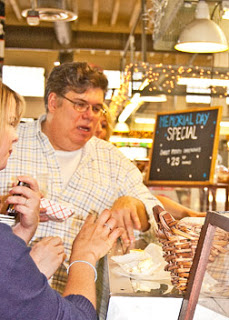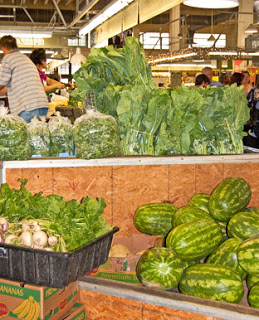 A while back David Leite of Leites Culinaria and I teamed up and had fun teaching a food writing workshop at a BlogHer food bloggers’ convention in Atlanta. The pics here show David enjoying some conference down time at Atlanta’s very charming and historic Sweet Auburn Curb Market (see details here).
A while back David Leite of Leites Culinaria and I teamed up and had fun teaching a food writing workshop at a BlogHer food bloggers’ convention in Atlanta. The pics here show David enjoying some conference down time at Atlanta’s very charming and historic Sweet Auburn Curb Market (see details here).
In our fairly focused and fast-paced session, David and I dished up a lot of how-to info, and our audience seemed highly receptive. (David is not only a fine writer but also an entertaining speaker and all round likeable guy! ) I previously posted a hand-out with the nitty-gritty of what we covered in the session called Seven Steps to Tastier Food Writing, in case you’re interested in the details.

While it was great to hear from attendees that they’d found our presentation useful and enjoyable, actually practicing the techniques mentioned is usually the key to writing better. Improving writing skills is very much a matter of learning by doing.
Here are some writing exercises I’ve given out for attendees to practice in some of my previous day-long writing workshops. After they practice a few minutes, I ask volunteers to read what they produced–the improvement in their prose is usually dramatic! Often, students say the hands-on activities are the most effective part of the whole day. And occasionally, I hear from former students that the exercise worksheets have been helpful long after they took my class. I’m positive you’ll see improvements if you take the time to try them. (And your little self-paced tutorial is completely free!) If you do try them, PLEASE come comment on your results.
 Practice Exercise 1–Use Active Verbs
Practice Exercise 1–Use Active Verbs
Concentrate on using strong, active verbs to power your sentences. First, watch a TV chef or a friend cooking, or perhaps observe what’s happening at a famers’ market. Then write several paragraphs describing the activity. Use only interesting, meaningful verbs and only active voice. (For a handy list of culinary action verbs, go here.) Try to make the reader visualize the action and scene.
Be careful to avoid sentences like, “The vegetables were being laid out in the stall.” This is passive voice, which imparts relatively little information, and is dull, dull, dull. Instead, be livelier, clearer, and more direct by saying who is prepping and what exactly he or she is doing. Here’s an example of the active voice construction: “The old man at the produce stall deftly shucked away the green husks, plucked off the silk, and stacked the ears of corn neatly in a woven basket at the end of his counter.” Better, don’t you think?
Practice Exercise 2–Choose Vivid Adjectives and Adverbs
Describe a dish or ingredient so enticingly that peeps will be drooling for it. If you create recipes, pick one and write an introduction so readers will know exactly what to expect if they make it. Start by repeatedly tasting the food yourself and noting down the interesting details. Remember that food stimulates all the senses, so pay attention to not only the taste, but texture and aroma and even the sounds involved in eating it. (For a whole post on writing recipe intros or headnotes, go here.)
Be sure to use specific and thoughtfully-chosen adjectives and adverbs. One cookbook editor I’ve worked with warns authors that she only allows one “delicious,” per book! Here is a perfect example of adjectives and adverbs she does NOT want to see: “This apple crisp is quite mouthwatering and very delicious and would be scrumptious for dessert.” I bet she’d become apoplectic if she read that one!
Merely being more specific and fresher will make your prose more vivid and compelling, as you can see in the following example from my All-American Dessert Book: “This voluptuous, generous pie will disappear quickly. The filling is deeply lemony and packs a little puckery punch; the meringue is cloud-like and not overly sweet.”
Practice Exercise 3–Self-Edit Your Prose
Self-editing enables a writer to pare away wordy phrases and passages, cut clichés, rework passive constructions, eliminate redundancies, and improve word choices. Try editing a passage you wrote and allowed to sit a few days by reducing the word count by at least a third (without deleting any key information). Unless you write extraordinarily “tight,” it will be easier to do than you think! Your rewrite will be much more compelling; if you compare the before and after versions, you’ll see for yourself!
For more pics and info on the Sweet Auburn Curb Market, go here.
For another popular post on a different aspect of food writing, check out “Five Things NEVER to Say to a Food Editor.”
Or perhaps you’d like, “Food Writing Lessons I’ve Learned the Hard Way.”


Hi, thanks for dropping by. Yes, these exercises are pretty much no-fail, weeding verbiage and improving verb and descriptor choices just HAS to make your writing better!
Hi Nancy,
This is great advice and I remember these tips from the session at BlogHer Food last year. Sleeping on it is also a great idea. I do that with every post. Things always appear different in the morning.
The exercises look great. I'm goning to try them.
Jane, I definitely agree. I strive for a certain cadence–the writing must seem to flow and if when I read it and a passage stops me,this is a sign that it needs some work.
Thanks for your input. As Willa pointed out, the same tips will help you write better even if you're not focusing on food. Concentrating on using lively verbs, minimizing descriptors, and self-editing help any prose sing rather than read like a tech manual.
Amy Ruth, do let me hear how it goes if you try these exercises-think you'll be pleased.
Definitely great tips, Nancy. I agree with all of it. Another thing I also tend to do, as I'm editing a piece of writing, is to read it aloud to myself (often very softly, or sometimes just in my head–depends who's around!). It's easy to scoff at that idea, but I think it's imperative that people understand what their writing sounds like when it's actually spoken. Does it flow like music, or does it sound like you're reading the phone book? If it's the latter, rewrite! I give the same simple advice to my kids, and it has helped them considerably over the years.
Nancy, The activity of teaching others to be better at writing is a great verb! :") I am looking forward to more practice on my little spot in the universe. I'll be back for more direction and practice suggestions. In the mean while. Many thanks for helping all of us who are listening to your voice. Happy Friday!
AmyRuth
I know you're focused on food, but it's actually good advice for any writer.
Wonderful advice and helpful examples. I never have the gift for words and my recipes are worded more like technical manuals. Thanks!
Wonderful advice–all of it. I think anyone contemplating writing their own community cookbook, or even a short article about food, should read this. Thanks!
Good point–some editors feel that all adverbs and adjectives are crutches and should be used sparingly or not at all. I think the RIGHT ones are fine, but never, ever resort to mouthwatering or delicious because they are overused and don't really tell HOW the food is tasty.
I agree. I often get more "description" out of verbs than out of adjectives and adverbs. Also, when I write I always try to put the piece away for a few days. It's a good technique for spotting problems